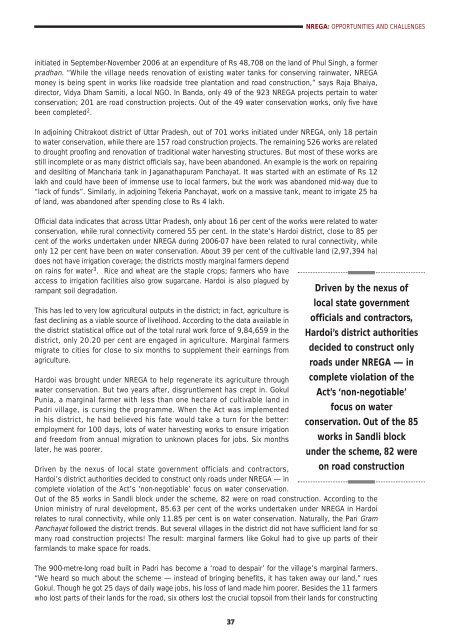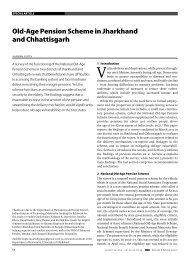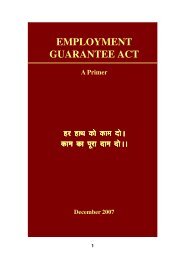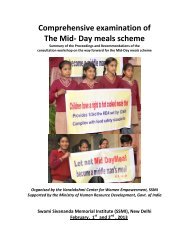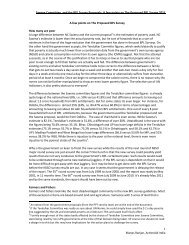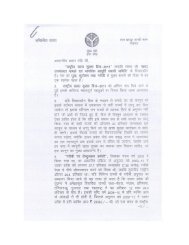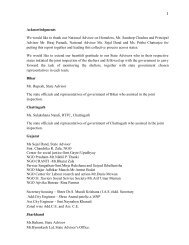NREGA: Opportunities and Challenges - Diksha
NREGA: Opportunities and Challenges - Diksha
NREGA: Opportunities and Challenges - Diksha
You also want an ePaper? Increase the reach of your titles
YUMPU automatically turns print PDFs into web optimized ePapers that Google loves.
<strong>NREGA</strong>: OPPORTUNITIES AND CHALLENGESinitiated in September-November 2006 at an expenditure of Rs 48,708 on the l<strong>and</strong> of Phul Singh, a formerpradhan. “While the village needs renovation of existing water tanks for conserving rainwater, <strong>NREGA</strong>money is being spent in works like roadside tree plantation <strong>and</strong> road construction,” says Raja Bhaiya,director, Vidya Dham Samiti, a local NGO. In B<strong>and</strong>a, only 49 of the 923 <strong>NREGA</strong> projects pertain to waterconservation; 201 are road construction projects. Out of the 49 water conservation works, only five havebeen completed 2 .In adjoining Chitrakoot district of Uttar Pradesh, out of 701 works initiated under <strong>NREGA</strong>, only 18 pertainto water conservation, while there are 157 road construction projects. The remaining 526 works are relatedto drought proofing <strong>and</strong> renovation of traditional water harvesting structures. But most of these works arestill incomplete or as many district officials say, have been ab<strong>and</strong>oned. An example is the work on repairing<strong>and</strong> desilting of Mancharia tank in Jaganathapuram Panchayat. It was started with an estimate of Rs 12lakh <strong>and</strong> could have been of immense use to local farmers, but the work was ab<strong>and</strong>oned mid-way due to“lack of funds”. Similarly, in adjoining Tekeria Panchayat, work on a massive tank, meant to irrigate 25 haof l<strong>and</strong>, was ab<strong>and</strong>oned after spending close to Rs 4 lakh.Official data indicates that across Uttar Pradesh, only about 16 per cent of the works were related to waterconservation, while rural connectivity cornered 55 per cent. In the state’s Hardoi district, close to 85 percent of the works undertaken under <strong>NREGA</strong> during 2006-07 have been related to rural connectivity, whileonly 12 per cent have been on water conservation. About 39 per cent of the cultivable l<strong>and</strong> (2,97,394 ha)does not have irrigation coverage; the districts mostly marginal farmers dependon rains for water 3 . Rice <strong>and</strong> wheat are the staple crops; farmers who haveaccess to irrigation facilities also grow sugarcane. Hardoi is also plagued byrampant soil degradation.This has led to very low agricultural outputs in the district; in fact, agriculture isfast declining as a viable source of livelihood. According to the data available inthe district statistical office out of the total rural work force of 9,84,659 in thedistrict, only 20.20 per cent are engaged in agriculture. Marginal farmersmigrate to cities for close to six months to supplement their earnings fromagriculture.Hardoi was brought under <strong>NREGA</strong> to help regenerate its agriculture throughwater conservation. But two years after, disgruntlement has crept in. GokulPunia, a marginal farmer with less than one hectare of cultivable l<strong>and</strong> inPadri village, is cursing the programme. When the Act was implementedin his district, he had believed his fate would take a turn for the better:employment for 100 days, lots of water harvesting works to ensure irrigation<strong>and</strong> freedom from annual migration to unknown places for jobs. Six monthslater, he was poorer.Driven by the nexus oflocal state governmentofficials <strong>and</strong> contractors,Hardoi’s district authoritiesdecided to construct onlyroads under <strong>NREGA</strong> — incomplete violation of theAct’s ‘non-negotiable’focus on waterconservation. Out of the 85works in S<strong>and</strong>li blockunder the scheme, 82 wereon road constructionDriven by the nexus of local state government officials <strong>and</strong> contractors,Hardoi’s district authorities decided to construct only roads under <strong>NREGA</strong> — incomplete violation of the Act’s ‘non-negotiable’ focus on water conservation.Out of the 85 works in S<strong>and</strong>li block under the scheme, 82 were on road construction. According to theUnion ministry of rural development, 85.63 per cent of the works undertaken under <strong>NREGA</strong> in Hardoirelates to rural connectivity, while only 11.85 per cent is on water conservation. Naturally, the Pari GramPanchayat followed the district trends. But several villages in the district did not have sufficient l<strong>and</strong> for somany road construction projects! The result: marginal farmers like Gokul had to give up parts of theirfarml<strong>and</strong>s to make space for roads.The 900-metre-long road built in Padri has become a ‘road to despair’ for the village’s marginal farmers.“We heard so much about the scheme — instead of bringing benefits, it has taken away our l<strong>and</strong>,” ruesGokul. Though he got 25 days of daily wage jobs, his loss of l<strong>and</strong> made him poorer. Besides the 11 farmerswho lost parts of their l<strong>and</strong>s for the road, six others lost the crucial topsoil from their l<strong>and</strong>s for constructing37


